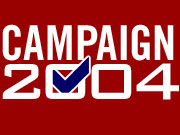Audio
Photos
Resources
Your Voice
| ||||||||||||||||||||||||||||||||||||||||||||
Independent organizations are scaling back political TV ads
October 3, 2004
 |
| A Kerry ad (Kerry TV ad) |
St. Paul, Minn. — It may not seem like campaign ad buys are down, when nearly every television newscast is filled with ads for the presidential candidates.
While the Bush and Kerry campaigns are gobbling up airtime in the final weeks, some groups that traditionally spend a lot of money on TV ads are cutting back. The Sierra Club spent $4 million on television advertising in the 2000 presidential race, but will spend virtually nothing this year.
 | |||
Sierra Club Executive Director Carl Pope says the environmental organization is putting its resources into a voter education drive in Minnesota and eight other swing states. Pope says the Sierra Club found that its ad buys weren't motivating environmentalists to vote.
"What gets people to the polls is your neighbors, not your television. You need for your neighbors or people at work or people you went to college or high school with to talk to you about the importance of voting, to talk to you about the differences between the candidates. An ad may get you angry, but it won't get you off your sofa," Pope says.
Pope says instead of buying television time, the Sierra Club is targeting people who don't vote regularly, but care about the environment. Volunteers will make numerous contacts with about 20,000 Minnesota households.
Another group that's scaling back its television advertising is NARAL Pro-Choice America. Interim president Betsy Cavendish says TV ads cast a wide net, but they're expensive and somewhat superficial.
"Many of the young people we're trying to target don't watch as much television and are not as swayed by that kind of type of advertising, but they rely on the Internet as the first place to turn to for information. And so we've built an unprecedented online campaign this year and believe that it's showing some real results in getting our message out to our target audience," she said.
 | |||
Cavendish says NARAL is also using mail, phone calls and door-to-door contacts to talk about the presidential race. The decision by NARAL and the Sierra Club to focus on more targeted advertising reflects a larger trend in the industry, according to ad expert Ron Faber. Faber, who teaches advertising at the University of Minnesota, says advertisers are generally spending less money on television right now.
"Prime-time television is not attracting the kinds of audience it once did, and so the so-called bang for your buck, the amount of impact your dollars have, is less and less now," according to Faber.
Faber says consumers also tend to be skeptical of television ads, and the most skeptical group is young people in their late teens and early 20s.
While some interest groups are cutting back on ad spending, the presidential campaigns are putting a lot of money into Minnesota this year. WCCO-TV station manager Trey Fabacher says the campaigns spent about $10 million in the Twin Cities market in the spring. He says spending tapered off in the summer, but is ramping up again for the final weeks of the campaign.
"The money is more than the market anticipated, but it's still a lot less than 2002 and 2000," Fabacher said.
Fabacher says the main reason political ad buys are down from the last two election cycles is that there are no statewide races on the ballot.
"The presidential campaign has spent a lot of money in this marketplace. But if you still have mainly one race, there's a saturation point in the marketplace as far as how much that message gets out. If you've got four or five hotly-contested deep-pocket races, you're always going to have a lot more money."
Two years ago, Minnesota had a governor's race and a U.S. Senate race, and four years ago, spending on the presidential campaign was far outpaced by an expensive Senate race. That year, Mark Dayton alone spent more than $11 million of his own money on his successful Senate bid. Most of that money went for 25 television ads.
|
News Headlines
|
Related Subjects
|

